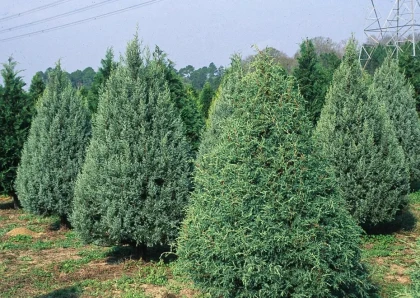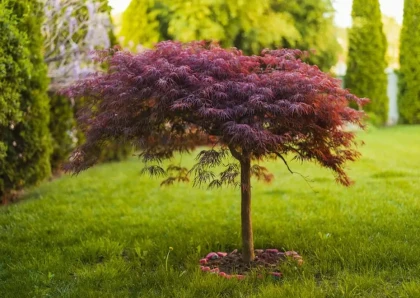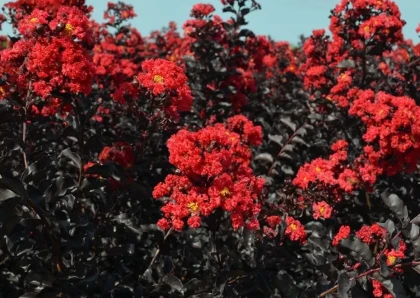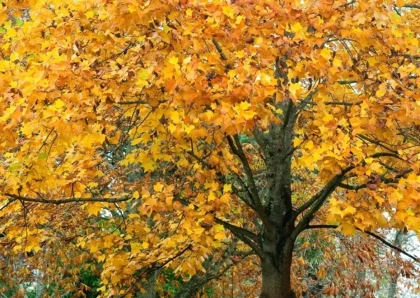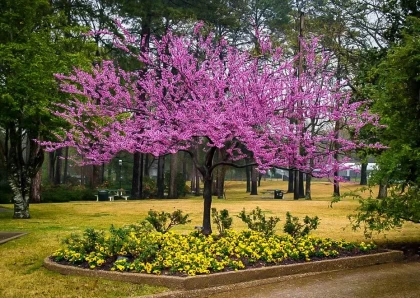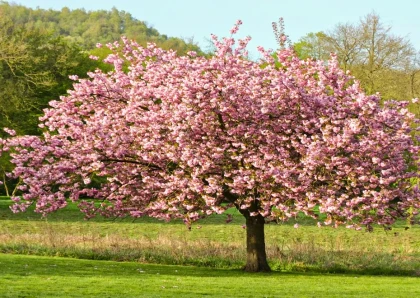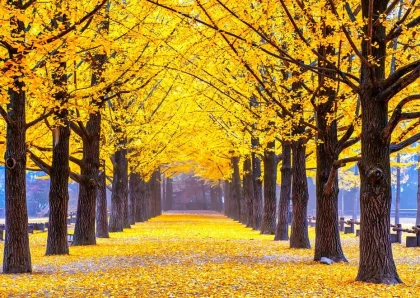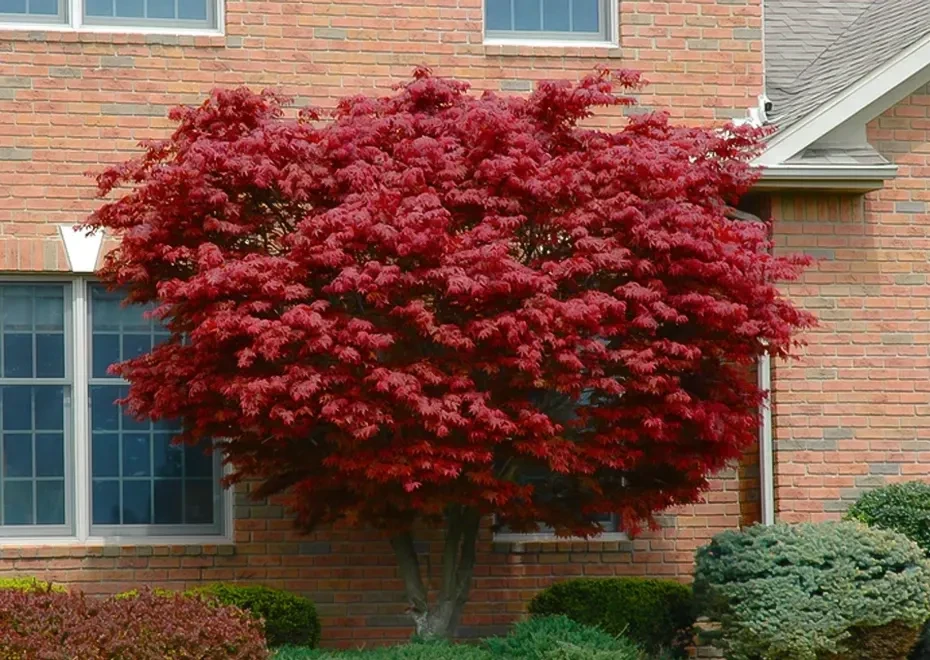
Bloodgood Japanese Maple Tree
Overview
History of the Bloodgood Japanese Maple Tree
The Bloodgood Japanese Maple tree, scientifically known as Acer palmatum 'Bloodgood,' is a cultivar that originated in Japan. It was first introduced to the United States in the 19th century and has since become one of the most popular and beloved Japanese Maple varieties worldwide.
Detailed Description of the Bloodgood Japanese Maple Tree
The Bloodgood Japanese Maple is a stunning deciduous tree renowned for its captivating beauty. It features deeply lobed, palmate leaves that emerge burgundy-red in spring, transition to a rich dark purple-red in summer, and turn a vibrant crimson in fall. The tree typically grows up to 20 feet tall with a spread of 15 feet, forming an elegant, rounded canopy that adds grace and charm to any landscape.
Types of the Bloodgood Japanese Maple Tree
The Bloodgood cultivar belongs to the Acer palmatum species, which encompasses various other cultivars with unique characteristics. Some notable cultivars include 'Dissectum' with finely cut leaves, 'Sango Kaku' with coral-red branches, and 'Osakazuki' with brilliant scarlet fall color. Each cultivar offers its own distinct beauty and can be selected based on personal preferences and specific landscape needs.
Importance of the Bloodgood Japanese Maple Tree
The Bloodgood Japanese Maple holds great importance in landscaping and gardening due to its aesthetic appeal and versatility. It serves as a focal point in gardens, providing a burst of color and texture throughout the seasons. The tree's graceful silhouette and striking foliage make it ideal for creating visual interest, enhancing garden designs, and adding a touch of elegance to any outdoor space.
How to Care for the Bloodgood Japanese Maple Tree
To ensure the optimal health and beauty of your Bloodgood Japanese Maple tree, follow these care guidelines:
- Location: Plant the tree in a well-drained area with partial shade, protecting it from harsh afternoon sun and strong winds.
- Soil: Use rich, moist soil with a slightly acidic to neutral pH level.
- Watering: Provide regular watering, especially during dry periods, ensuring the soil remains evenly moist but not waterlogged.
- Pruning: Prune the tree during the dormant season to maintain its shape, remove dead or crossing branches, and promote healthy growth.
- Mulching: Apply a layer of organic mulch around the base of the tree to conserve moisture, suppress weed growth, and regulate soil temperature.
- Fertilization: Apply a balanced, slow-release fertilizer in spring to provide essential nutrients.
Benefits of the Bloodgood Japanese Maple Tree
The Bloodgood Japanese Maple offers a range of benefits, including:
- Ornamental Value: The tree's stunning foliage and attractive form make it a prized ornamental tree, adding beauty and visual interest to landscapes.
- Seasonal Interest: From its striking red leaves in spring to its vibrant crimson foliage in fall, the Bloodgood Japanese Maple provides ever-changing beauty throughout the year.
- Compact Size: With a moderate height and spread, the tree is suitable for small to medium-sized gardens and can be grown in containers.
- Low Maintenance: Once established, the Bloodgood Japanese Maple requires minimal maintenance, making it an excellent choice for busy gardeners.
- Wildlife Habitat: The tree's dense foliage provides shelter for birds and small wildlife, contributing to the overall biodiversity of the area.
How to Plant the Bloodgood Japanese Maple Tree
Follow these steps to plant your Bloodgood Japanese Maple tree:
- Choose a location with well-drained soil and partial shade.
- Dig a hole that is twice as wide and slightly shallower than the root ball.
- Gently remove the tree from its container, ensuring not to disturb the roots.
- Place the tree in the hole, ensuring it is level and centered.
- Backfill the hole with soil, firming it gently around the roots.
- Water the tree thoroughly to settle the soil and remove any air pockets.
- Apply a layer of mulch around the base of the tree, leaving space around the trunk.
Different Types of Wood Products That Can Be Made from the Bloodgood Japanese Maple
The wood of the Bloodgood Japanese Maple tree is highly valued for its fine-grained texture and attractive appearance. It is commonly used in the crafting of furniture, cabinetry, musical instruments, and decorative veneers. The rich, dark wood with subtle grain patterns adds a touch of elegance and warmth to these wood products.
Cons of the Bloodgood Japanese Maple Tree
While the Bloodgood Japanese Maple is a remarkable tree, there are a few considerations to keep in mind:
- Sensitivity to Sun: The tree may experience leaf scorch if exposed to excessive sun, particularly in hot climates.
- Shallow Roots: The Bloodgood Japanese Maple has shallow, delicate roots that require careful handling and protection from foot traffic or heavy machinery.
- Variable Fall Color: While the tree typically displays vibrant red foliage in fall, the intensity and duration of the color can vary depending on environmental conditions.
FAQs (Frequently Asked Questions) about the Bloodgood Japanese Maple Tree
Q: Is the Bloodgood Japanese Maple tree suitable for small gardens?
A: Yes, the compact size of the Bloodgood Japanese Maple makes it an excellent choice for small to medium-sized gardens and even container gardening.
Q: Does the Bloodgood Japanese Maple tree require full sun?
A: While the tree can tolerate some sun, it prefers partial shade to protect its delicate foliage from scorching.
Q: How often should I water my Bloodgood Japanese Maple tree?
A: Water the tree regularly, especially during dry periods, ensuring the soil remains evenly moist but not overly saturated.
Q: Can I grow the Bloodgood Japanese Maple tree in a pot or container?
A: Yes, the Bloodgood Japanese Maple can be grown in containers as long as they provide adequate drainage and room for the tree's root system to develop.
Q: Does the Bloodgood Japanese Maple tree attract wildlife?
A: The dense foliage of the Bloodgood Japanese Maple provides shelter for birds and small wildlife, making it attractive to wildlife enthusiasts.
No listings available
Related Products
Questions & Answers
What do you want to know about this product?
Reviews (5)
FoliageFanatic13
A Captivating Beauty That Steals the Spotlight!
The Bloodgood Japanese Maple is a mesmerizing masterpiece in my garden. Its rich red leaves add drama and allure.
TreeWhisperer88
The Epitome of Elegance and Grace
The Bloodgood Japanese Maple exudes timeless charm. Its delicate leaves and graceful form make it a garden sensation.
LeafLover23
A Jewel Amongst Maples
The Bloodgood Japanese Maple shines with its fiery foliage. A radiant gem that elevates the beauty of any landscape.
ArborArtisan42
Throughout the Seasons
The Bloodgood Japanese Maple is a true artist, painting my garden with hues of red, purple, and crimson. Nature's masterpiece!
GardenGuru99
Delight for the Senses
The Bloodgood Japanese Maple is a sensory delight. Its vibrant foliage, graceful branches, and delicate texture create an enchanting experience.





